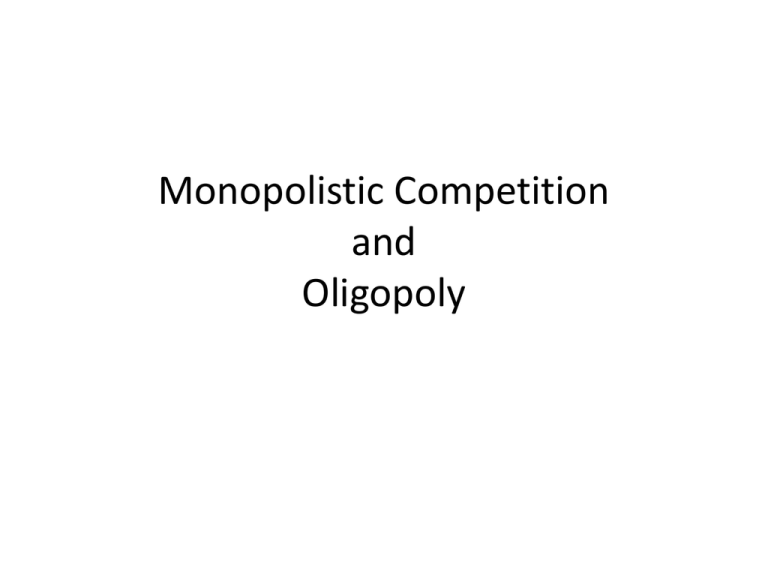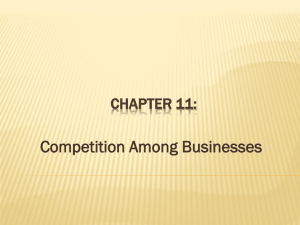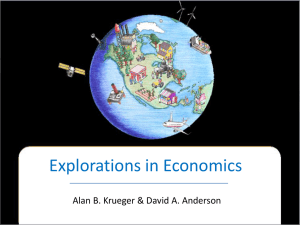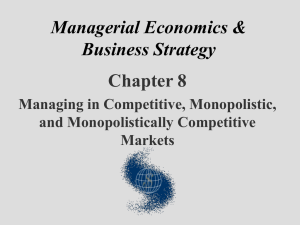Monopolistic Competition and Oligopoly
advertisement

Monopolistic Competition and Oligopoly • Somewhere between the two extremes of monopoly and perfect competition • Two forms – Monopolistic Competition – Oligopoly • Monopolistic Competition – Many sellers, but – Product Differentiation – So face a downward sloping demand curve – Not Price Takers • Oligopoly – Only a few seller – Offer similar or identical products Monopolistic Competition • Key Points • Like a monopoly – Faces a downward sloping demand curve – Sets its own price – Marks up price over quantity • But not – Not really a monopoly – Almost because it tries to make its product different – But its not different, so can’t push the monopoly mindset too far, because people will go to other close substitutes • Profit in the long run? – If firms making lots of profit maybe more firms come in with close substitutes – This would lower the firms demand and MR curve and also profits – Could this lead then to zero LR profits? – If they haven’t sufficiently differentiated their product, yes – But if they have, no – Because consumers might feel there are no real substitutes – Think Athletic Shoes Monopolistic Competition and Advertising • If a firm is selling a differentiated product and making a profit (price > MC) • Then there is an incentive to advertise – To attract more buyers (increase demand and MR curve) – And to keep their product differentiated • Is advertising bad? – Manipulates people’s tastes – Psychological, not informative – Impedes competition – Differentiating products that are really the same (brand loyalty) • Is it good? – Gives information – Fosters competition (consumers take advantage of price differences among similar products) – Allows new firms to enter easier • Does it make sense that consumers buy brand names? • Essentially the same product as store brands, but cost more, partly because they advertise • But maybe they are higher quality, and they have an incentive to keep higher quality to defend the brand Oligopoly • • • • Only a few sellers Similar or identical products Interdependent Game Theory – How people behave in strategic situations – If only a few, I need to consider how they’ll respond to my actions • Tension between cooperating and competing • Best off cooperating and acting like a monopoly – Produce small amount – P > MC • But each only cares about own self interest – Incentive to compete Duopoly Example • • • • • Only two firms Same product Each decides quantity to sell Price is set by the market demand Thus the combination of both seller’s choice of Q leads to the price and so their profits • They could collude and act as a monopoly – Come to an agreement on price or quantity – But generally explicit collusion is illegal (but can still act strategically) • Thus forming a Cartel – Think of OPEC Economics of Cooperation • Prisoner’s Dilemma – A “game” – Illustrates why cooperation can be hard even if both would benefit • Dominant Strategy – A strategy that is best for a player in a game regardless of what others do A Confess Don’t A gets 8 yrs prison A gets 20 yrs prison Confess B gets 8 yrs prison B goes free B A gets 1 yrs prison A goes free Don’t B gets 20 yrs prison B gets 8 yrs prison • Regardless of what A does it is better for B to confess – Dominant Strategy • Regardless of what B does if is better for A to confess – Dominant Strategy • So they both confess and both get 8 yrs instead of both getting off • Of course this is if they can’t collude • This is similar to the situation face by two firms in a duopoly • • • • Two firms in a duopoly face a similar “game” If colluded could reach higher profits But can’t directly collude Becomes a strategic game Demand Schedule and Profit Gallons Market Price Total Revenue (Total Profit) 0 $120 $0 10 110 1,100 20 100 2,000 30 90 2,700 40 80 3,200 50 70 3,500 60 60 3,600 70 50 3,500 80 40 3,200 90 30 2,700 100 20 2,000 Duopoly “Game” A High Production 40 Gallons Low Production 30 Gallons A gets $1.6K profit A gets $1.5K profit High P 40 G B gets $1.6K profit B gets $2K profit B A gets $1.8K profit A gets $2K profit Low P 30 G B gets $1.5K profit B gets $1.8K profit Application to OPEC • Organization of Petroleum Exporting Countries • Control about ¾ of worlds oil reserves • Tries to set production limits to keep price of oil sufficiently high (but not too high to cause long term shift in demand) • Each country then has incentive to deviate a bit – Because still get benefit of higher price but also get to sell more, but if all do this then price falls – Success at setting high price in 70’s and early 80’s but since then not so much Arms Race Example • Cold war arms race between US and Soviet Union • Two strategies – Arm – Disarm • Dominant Strategy – Arm Cold War “Game” US Arm Disarm US at risk US at risk and weak Arm Soviet at risk Soviet safe and strong Soviet US safe US safe and strong Disarm Soviet at risk and weak Soviet safe • Game’s implication for welfare • Noncooperative Equilibrium – Dominant Strategy – Could be good for society • Gets away from monopoly production – Could be bad • Gets us a world full of nuclear warheads How to Still Get Cooperation • Repeated Games – Dominant strategy is such because game only played once • Start out at best position • Penalize players for deviating – Tit for Tat Public Policy • Anti Trust Laws • Sherman Act, 1890 – Made agreements between oligopolists a crime • Clayton Act, 1914 – Strengthened anti trust laws • Prevent Certain Mergers • Prevent Collusion Predatory Pricing • Selling below cost in order to drive out a competitor • Then when competitor gone can act as a monopoly • Illegal under anti trust policies • Deemed anticompetitive • Rockefeller strategy in oil (Cincinnati/Chicago) • Lower price in Cincinnati to drive out competition, but raise price in Chicago where competition had already been driven out











